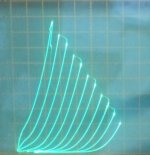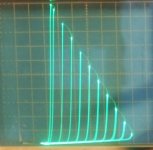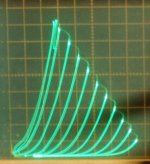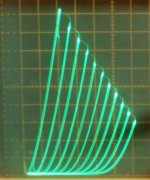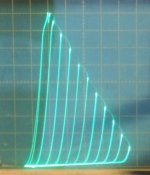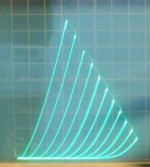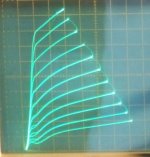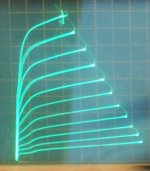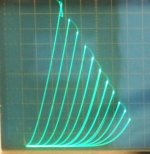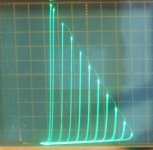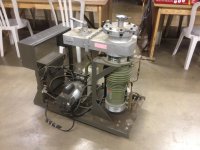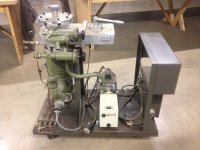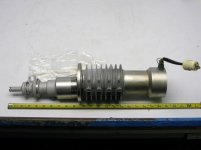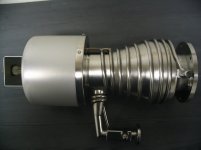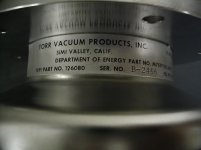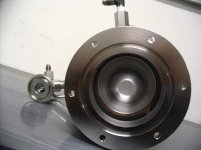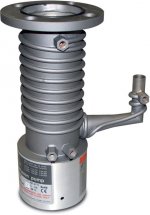Here are some "Schade" curves for the 6HJ5, which worked well for George earlier. (100 Watt output easily)
(50 mA/div, 50 V/div)
I would say the 300B has got some dead serious $5 competition.
Then for those who would like to make a smaller amp, Schade curves for the 9 pin, high gm, 6HB6 (another one of those $1 tubes, like the 21HB5A above ), 10 Watt diss, probably good for 20 Watts out. The steep curves (low effective Rp) should offer a really good damping factor, even without any global Fdbk.
(20 mA/div, 50 V/div)
And finally, I should note that Schaded tubes should not have much of an issue with paralleling similar tubes, because the Schade Fdbk network sets the gain, not internal tube details. So there's no issue with mis-tracking Mu between tubes here.
(50 mA/div, 50 V/div)
I would say the 300B has got some dead serious $5 competition.
Then for those who would like to make a smaller amp, Schade curves for the 9 pin, high gm, 6HB6 (another one of those $1 tubes, like the 21HB5A above ), 10 Watt diss, probably good for 20 Watts out. The steep curves (low effective Rp) should offer a really good damping factor, even without any global Fdbk.
(20 mA/div, 50 V/div)
And finally, I should note that Schaded tubes should not have much of an issue with paralleling similar tubes, because the Schade Fdbk network sets the gain, not internal tube details. So there's no issue with mis-tracking Mu between tubes here.
Attachments
Last edited:
6HB6 (another one of those $1 tubes, like the 21HB5A above ), 10 Watt diss, probably good for 20 Watts out.
OK, now that I have 500 of them, I will let the secret out and watch the $1 price vanish. I got mine for 35 cents each!!!!!
The 6HB6 IS a 6BQ5/EL84 with a high Gm grid. It was intended for video output and vertical sweep use in TV sets. It needs about half the drive / bias of the EL84, and doesn't sound quite the same in an overdriven guitar amp, but for $1, it works.
Caution, NOT the same pinout as the EL84. It will plug right into Pete's little red driver board, and deliver about 10 watts in the DRIVER board limited by the CCS in the tail.
I have squeezed 30 watts from a pair in a typical EL84 circuit with 420 volts on the plates, and 320 volts on the screens with a 6600 ohm load.
The 6HJ5 is also a good tube, but they have virtually vanished. Someone grabbed them all up.
Well, lets see. There's still 26DQ5 around for $3. And 29GK6 for $1. (an EL84 clone) Those $1 21HB5As have jumped to $6 unfortunately. Ahh, but 21JV6 is $3, nearly the same thing. And 21EX6 for $3.
Oh, there are plenty of 38HE7/12HE7 around ($1, were $0.35 in bulk), the pentode in these is close to the 21HB5A, but with a somewhat reduced size plate. And many of the 38HE7 versions have an IC (internal connection) pin that connects to the heater between the pentode and the damper. So you can power up just the pentode at 21V for the heater. The plate Watt dissipation should be OK at 16 Watts then, without the damper diode running. The 38HE7 pentode may also be close to the individual sections in the 42KN6 (the doubled version). Have to get a 42KN6 to try on the tracer yet to compare.
1) 26DQ5 in Schade
2) 26DQ5 in triode
3) 29GK6 in Schade
4) 29GK6 in triode
and for comparison with the 29GK6, the 6HB6 again:
5) 6HB6 in Schade
6) 6HB6 in triode
7) 29GK6 pentode
8) 6HB6 pentode
Oh, there are plenty of 38HE7/12HE7 around ($1, were $0.35 in bulk), the pentode in these is close to the 21HB5A, but with a somewhat reduced size plate. And many of the 38HE7 versions have an IC (internal connection) pin that connects to the heater between the pentode and the damper. So you can power up just the pentode at 21V for the heater. The plate Watt dissipation should be OK at 16 Watts then, without the damper diode running. The 38HE7 pentode may also be close to the individual sections in the 42KN6 (the doubled version). Have to get a 42KN6 to try on the tracer yet to compare.
1) 26DQ5 in Schade
2) 26DQ5 in triode
3) 29GK6 in Schade
4) 29GK6 in triode
and for comparison with the 29GK6, the 6HB6 again:
5) 6HB6 in Schade
6) 6HB6 in triode
7) 29GK6 pentode
8) 6HB6 pentode
Attachments
Last edited:
OOPs, looks like 29GK6 is $3 now.
12GE5 is $3 now, same tube as the DCPP 6JN6 (except the pinout is different)
Summer Dollar Days - Vacuum Tube Sale - $1.00 Vacuum Tubes
Quantity Specials
12GE5 is $3 now, same tube as the DCPP 6JN6 (except the pinout is different)
Summer Dollar Days - Vacuum Tube Sale - $1.00 Vacuum Tubes
Quantity Specials
Last edited:
I just figured out that there is someone (or more likely several people) in Hong Kong that reads our posts and immediately calls the tube dealers in the US and buys the ENTIRE STOCK of the tubes we talk about.
I called Stan at ESRC today and it seems that just last week someone bought all 10,000 6HB6's that he had in stock. He has a few hundred left in random places around the country that haven't made their way to Florida yet.
The 6HJ5's, all gone too. There was another tube that is very similar to the 6HJ5. He said that someone bought all of those he had last year. OK, that was me, about 75 tubes.
I used to think that if I found a tube which had thousands of units in stock, then it was safe to use in a new design. I realize now that is not true.
I haven't had much time for bench work in the last year, since I don't even have a workbench right now, but I have spent considerable time and money developing some new designs. I even have a new batch of PC boards that have not been seen on this forum yet, and one killer new amp that I actually breadboarded on the floor in the unheated garage during last winter. Too bad I can't get the tubes that go in it now. Someone in Hong Kong bought Stan's entire stock last week.
I have another amp that was discussed about a year ago that squeezed a lot of power out of some dollar tubes. There were 10's of thousands of them available in several places, so I only got 100. Now the large stock is gone. There are a few left here and there for $5 to $15 each.
If this practice continues, the only tubes we will have available will be the same 10 or 20 new production audio tubes, that I for one have no desire to work with.
We need to be a little more careful mentioning numbers if we ourselves want to have our favorite TV tubes to play with a while longer.
I called Stan at ESRC today and it seems that just last week someone bought all 10,000 6HB6's that he had in stock. He has a few hundred left in random places around the country that haven't made their way to Florida yet.
The 6HJ5's, all gone too. There was another tube that is very similar to the 6HJ5. He said that someone bought all of those he had last year. OK, that was me, about 75 tubes.
I used to think that if I found a tube which had thousands of units in stock, then it was safe to use in a new design. I realize now that is not true.
I haven't had much time for bench work in the last year, since I don't even have a workbench right now, but I have spent considerable time and money developing some new designs. I even have a new batch of PC boards that have not been seen on this forum yet, and one killer new amp that I actually breadboarded on the floor in the unheated garage during last winter. Too bad I can't get the tubes that go in it now. Someone in Hong Kong bought Stan's entire stock last week.
I have another amp that was discussed about a year ago that squeezed a lot of power out of some dollar tubes. There were 10's of thousands of them available in several places, so I only got 100. Now the large stock is gone. There are a few left here and there for $5 to $15 each.
If this practice continues, the only tubes we will have available will be the same 10 or 20 new production audio tubes, that I for one have no desire to work with.
We need to be a little more careful mentioning numbers if we ourselves want to have our favorite TV tubes to play with a while longer.
OMG, No more blabbing about super tubes.
All you people that bought up the 6HJ5s: I faked all those curves, you bought pure junk. Man did we put one over on you.
Hmmm, maybe the Chinese tube manufacturers are eliminating the competition.
Are these tubes showing up in anything being sold? Or just being crushed....
Well, in any case, I think the important thing is the Schade technique makes most any TV Sweep tube perform wonders.
All you people that bought up the 6HJ5s: I faked all those curves, you bought pure junk. Man did we put one over on you.
Hmmm, maybe the Chinese tube manufacturers are eliminating the competition.
Are these tubes showing up in anything being sold? Or just being crushed....
Well, in any case, I think the important thing is the Schade technique makes most any TV Sweep tube perform wonders.
I just figured out that there is someone (or more likely several people) in Hong Kong that reads our posts and immediately calls the tube dealers in the US and buys the ENTIRE STOCK of the tubes we talk about.
I knew it!
Or just being crushed....
OMG, don't say that. I'll have nightmares tonight.
jeff
Last edited:
Are these tubes showing up in anything being sold? Or just being crushed....
I don't pay much attention to other peoples amp designs, especially the Asian stuff on Ebay, so I don't know where the tubes are going.
I used to visit Stan's place (4 million tubes) at least twice a year, and often much more than that. That ended when I moved out of Florida, but I will see him at the Dayton hamfest in a few days. If I have time, I will pick his brain, and try to see what's up.
Previous conversations with him, and Dale at VacuumTubes.net lead me to believe that specific tubes, and sometimes brands are being hoarded.
Either these are being used in some designs, or more likely being hoarded until those who built 125 WPC versions of Petes board need new tubes.
The Dollar List started at VacuumTubes.net. It was a way to clear out tubes that were in high supply with no demand. Both them, and ESRC have computerized inventory systems that can tell them how many of a given tube they have, where they are, whether they are bulk, or individually boxed, and how many they have sold in each of the last 5 years, and at what price. Stan decided to copy the Dollar List idea and tweak it to match his own inventory. Dale, added the higher volume pricing (as low as 35 cents each) which Stan refused to match.
I have called Dale and been encouraged to buy a large volume of tubes with extremely low prices. Would you believe that I got 6HJ5's for $2 each? ( before I posted the #) I had to buy 500 6HB6's, and a bunch of other tubes that were on the $1 list to get that price. I bought 1200 tubes that day. This was about 2.5 years ago. He told me that someone in the Orient had just bought ALL (17,000) of his 7KY6's.
Stan has never sold me a new tube for less than $1 each.
I just figured out that there is someone (or more likely several people) in Hong Kong that reads our posts and immediately calls the tube dealers in the US and buys the ENTIRE STOCK of the tubes we talk about.
I've suspected as much. The ones I mentioned here about tripled in price after describing a new design I did. I got some of the really good ones in some odd heater voltage variations that were still really available and not ridiculously expensive. Sometimes, those are the ones available as the more conventional 6.3V versions are virtually unobtainium these days. (Doesn't bother me too much since I can do my own PTXs) It would seem they're getting more aggressive lately, though.
If this practice continues, the only tubes we will have available will be the same 10 or 20 new production audio tubes, that I for one have no desire to work with.
We need to be a little more careful mentioning numbers if we ourselves want to have our favorite TV tubes to play with a while longer.
I figured as much, and laid in a good supply of the types I'd be needing for existing projects, and new ones as well.
I'll have to get to the Hamvention to see about scoring more, both small signal and power finals. Haven't done much with run-of-the-mill audio types, other than 6AQ5s, but I use these as series pass devices for active screen regulators. They do work very well in that capacity.
I just figured out that there is someone (or more likely several people) in Hong Kong that reads our posts and immediately calls the tube dealers in the US and buys the ENTIRE STOCK of the tubes we talk about.
If this practice continues, the only tubes we will have available will be the same 10 or 20 new production audio tubes, that I for one have no desire to work with.
We need to be a little more careful mentioning numbers if we ourselves want to have our favorite TV tubes to play with a while longer.
And you are suprised?
There are 1000s and 1,000,000s of jobs in PRC that depend on know-how in the west being instantly copied there, then the industrially made reproductions re-appearing being dumped on the global market within days or weeks.
Forums like this represent the magic "know how", because they are peopled by a generation of people old enough and stupid enough to share that experience for free.
As you grow older you get more and more cynical and aware of people's motives especially when it's for profit.
In the end it's totally destroying of any motivation to do any form of work for enjoyment.
You know your brains are gonna be subverted, abused, and recycled by some little guy in a sweat shop in Asia so as he can sell his flash product down the road in a super market.
I have been there enough times to know!
I hate the whole idea of having to keep fun stuff to yourself.
It's against the whole ethos of the internet and a paying hobby, but there are people who never play by the same rules...
Last edited:
other than 6AQ5s
I have somewhere between 500 and 1000 of those. All used and untested. I had about 5000 of them from the lot of WWII military scrap I got about 20 years ago. Most were in poor condition with pins so corroded that they broke off when the tubes were inserted into a socket.
I got about 100,000 tubes in exchange for a couple days work, but they had been stored in a battered warehouse with the windows broken out apparently since the early 1950's. The warehouse was being demolished when someone decided that the contents were hazardous waste since some of those tubes contained mercury. My friend the surplus dealer agreed to remove the contents, and I got all the tubes. I must have found 30 or so broken 211's and 845's. There were several thousand 807's, most broken.
I "tested" some of the damaged 6AQ5's using clip leads to make connections. The 6AQ5 will red plate at just over its dissipation rating. There is only 1 or 2 watts between dull red plate, and hole in the glass, since they tightly crammed into the envelope. The original design criteria for the 6AQ5 was to stuff a 6V6 into a 7 pin miniature envelope. Don't push them too hard or they will melt!
"There are 1000s and 1,000,000s of jobs in PRC that depend on know-how in the west being instantly copied there, then the industrially made reproductions re-appearing being dumped on the global market within days or weeks."
---
"If this practice continues, the only tubes we will have available will be the same 10 or 20 new production audio tubes, that I for one have no desire to work with. "
---
What we need is a means to 3D print any tube guts we want from a data-file. Then re-useable vacuum envelopes (Two piece Pyrex with a Kalrez O-ring flange and electrical pin feed-thru's), and a small vacuum pump. That's probably calling for major corporate finance at this point though. Jet turbine parts are made this way now.
But maybe 3D printed tooling forms (plastic, limited production tolerance) for sheet metal stamping and grid winding forms. A specialty shop could then turn out the custom fabbed parts into a finished tube.
Or make your own:
The key thing I think is to eliminate the glass blowing part. Just use a re-usable bottom pinned/flanged pyrex vacuum container. The pins would have little set screw coupled sleeves for attaching the internal inter-connect wires. The hi-temp (Viton or Kalrez) O-ring seal would be recessed into the bottom glass flange for protection from electrons and heat. Basically, a repairable tube with a supply of custom parts. (some specialty shop could maybe offer a selection of pre-formed, mix and match, parts too) Some microwave tubes are made that way already.
My dad, as a youngster, used to take old tube parts and put them in a Mason jar, with carefully ground holes in the glass for rubber sealed screw feed-throughs.
Jeol Oil Diffusion Pump DP 4E | eBay
---
"If this practice continues, the only tubes we will have available will be the same 10 or 20 new production audio tubes, that I for one have no desire to work with. "
---
What we need is a means to 3D print any tube guts we want from a data-file. Then re-useable vacuum envelopes (Two piece Pyrex with a Kalrez O-ring flange and electrical pin feed-thru's), and a small vacuum pump. That's probably calling for major corporate finance at this point though. Jet turbine parts are made this way now.
But maybe 3D printed tooling forms (plastic, limited production tolerance) for sheet metal stamping and grid winding forms. A specialty shop could then turn out the custom fabbed parts into a finished tube.
Or make your own:
The key thing I think is to eliminate the glass blowing part. Just use a re-usable bottom pinned/flanged pyrex vacuum container. The pins would have little set screw coupled sleeves for attaching the internal inter-connect wires. The hi-temp (Viton or Kalrez) O-ring seal would be recessed into the bottom glass flange for protection from electrons and heat. Basically, a repairable tube with a supply of custom parts. (some specialty shop could maybe offer a selection of pre-formed, mix and match, parts too) Some microwave tubes are made that way already.
My dad, as a youngster, used to take old tube parts and put them in a Mason jar, with carefully ground holes in the glass for rubber sealed screw feed-throughs.
Jeol Oil Diffusion Pump DP 4E | eBay
Last edited:
This is turning out to be easier than I thought. The tube base design is the key thing.
Use a metal base with glass insulated pin feed-throughs, like hermetic sealed relays use. The base would have a machined in O-ring groove around the edge, and the base would attach to the metal chassis for cooling (keeping the O-ring seal cool).
The base would also have a small pipe in it, with a valve, for evacuation. This "valve" might be nothing more that a flipped around propane cylinder seal. (spring loaded ball against an O-ring, with an insertion pin to unload it during pump down) The electrical pin feed-throughs would have socket pins up top (inside) for inserting inter-connect wires.
The mix n match tube components would come from the specialty supplier with a pre-attached inter-connect wire and alignment posts for insertion into standard selected mica forms. (probably could get pre-formed ceramic sheets now, instead of mica)
So you just select from standard size groups: cathode, grids (several pitches and sizes available) and plate. Assemble the pieces in the ceramic forms and insert the inter-connect wires into the socket pins. Drop the Pyrex bottle over the base, and evacuate.
Tube rolling would take on a whole new meaning:
Wait a minute, I'm going to change the grid to a frame grid on the input stage.....
And one could make the whole amp as an "IC", using one large base with multiple pin groups for all the tubes in the amp.
Use a metal base with glass insulated pin feed-throughs, like hermetic sealed relays use. The base would have a machined in O-ring groove around the edge, and the base would attach to the metal chassis for cooling (keeping the O-ring seal cool).
The base would also have a small pipe in it, with a valve, for evacuation. This "valve" might be nothing more that a flipped around propane cylinder seal. (spring loaded ball against an O-ring, with an insertion pin to unload it during pump down) The electrical pin feed-throughs would have socket pins up top (inside) for inserting inter-connect wires.
The mix n match tube components would come from the specialty supplier with a pre-attached inter-connect wire and alignment posts for insertion into standard selected mica forms. (probably could get pre-formed ceramic sheets now, instead of mica)
So you just select from standard size groups: cathode, grids (several pitches and sizes available) and plate. Assemble the pieces in the ceramic forms and insert the inter-connect wires into the socket pins. Drop the Pyrex bottle over the base, and evacuate.
Tube rolling would take on a whole new meaning:
Wait a minute, I'm going to change the grid to a frame grid on the input stage.....
And one could make the whole amp as an "IC", using one large base with multiple pin groups for all the tubes in the amp.
Last edited:
My dad, as a youngster, used to take old tube parts and put them in a Mason jar
I took a live tube, made some measurements on it, broke the glass, then placed the remains inside a high vacuum chamber and retested. It didn't work as good. This happened back in about 1980, so I am a bit fuzzy on the details.
We had some serious HiVac equipment used in the manufacture of quartz crystals and thin film microelectronics. There was even a neat vacuum tube used to measure the quality of the vacuum.
Hot-filament ionization gauge - Wikipedia, the free encyclopedia
The $49 diffusion pump is cool, but only one small piece in a hivac system. As with any system, all the pieces must be sized correctly for everything to work. A diffusion pump must be backed up by a mechanical roughing pump. The diffusion pump operates at a high temp, and is basically an oil jet that pushes stray molecules along toward the roughing pump. If the oil is at temp and sees atmosphere, it will "crack" and must be discarded. Our systems also incorporated a cold trap which is a stainless steel flask filled with liquid nitrogen. This freezes any moisture in the system, and keeps it there until the weekly system shutdown and cleaning. Everything is cleaned with acetone and reassembled and sealed with vacuum grease. The roughing pump removes all the air from the system. The system must be at a certain vacuum level before the diffusion pump is started.
We learned the hard way that sticking the wrong thing in a high vacuum system can contaminate everything, forcing a complete teardown and cleaning. Organic material, like a mouse skeleton ( that one wasn't us, we just had to do the teardown) or FR4 PC board material (that was us), will do it.
I left the factory support group in 1984, and the factory was slowly dismantled and offshored, or outsourced in the years that followed. All the cool toys were gone.
Yep, full vacuum systems tend to be expensive. There's gauging at different points (roughing line and chamber) needed, and different gauges for different vacuum levels as well. Valves, vacuum fittings, leak detection, residual gas analysis, feedthroughs. If one takes some time (a year or so) and knows what they are doing, I have heard of people putting together a full system for a few hundred $, but more typical is a couple $1000.
I got a full roll around Varian vacuum cart last year for $400. It's got a VHS-4 diffusion pump, Varian SD-300 (Alcatel) roughing pump, slide valve, baffle, control box and a bay for vacuum gauge readouts. Appears to have been hardly used, paint is new on the diff pump heater, and the inside is sparkling clean. It's about 1000X too big for whats needed for evacuating vacuum tubes, but hey it was cheap. (and the shipping was free, I tied it onto the top of my old kayaking car)
I have some smaller diff pumps, including an air cooled one (Veeco EP-3B), that I have arranged to fit on the cart for more practical vacuum experimenting. (that VHS-4 draws 1450 Watts! And the roughing pump another 1500 Watts for starting) And I've had a small Varian HS-2 pump system since the 80's. Best diff pump I've found on Ebay was a new Torr-Vac 3" made for some government contract, man is it well made and efficient too.
$100, probably cost some taxpayers $10,000
Everything typically uses Silicone DC704 diff pump oil nowadays, so is impervious to air exposure. But still not recommended. Diff pumps just never wear out either and are usually stainless steel. Clean an old one, and check the heater, and you are good to go.
Then there is the whole other technology of vacuum turbo pumps. You can get small used ones for cheap, but typically the high speed bearings are shot. Takes a controller too. The big ones are too dangerous to have around the home. (A screw rolled into an Intel turbo once and it took out the whole lab. Even the small ones are precarious, a sales rep lost his hand once demo'ng a small turbo, when a bearing failed. ) These things routinely need new (expensive) high speed ceramic bearings. And the manufacturers recommend new (expensive) turbo bearing oil yearly, even if its been just sitting on the shelf.
I got a full roll around Varian vacuum cart last year for $400. It's got a VHS-4 diffusion pump, Varian SD-300 (Alcatel) roughing pump, slide valve, baffle, control box and a bay for vacuum gauge readouts. Appears to have been hardly used, paint is new on the diff pump heater, and the inside is sparkling clean. It's about 1000X too big for whats needed for evacuating vacuum tubes, but hey it was cheap. (and the shipping was free, I tied it onto the top of my old kayaking car)
I have some smaller diff pumps, including an air cooled one (Veeco EP-3B), that I have arranged to fit on the cart for more practical vacuum experimenting. (that VHS-4 draws 1450 Watts! And the roughing pump another 1500 Watts for starting) And I've had a small Varian HS-2 pump system since the 80's. Best diff pump I've found on Ebay was a new Torr-Vac 3" made for some government contract, man is it well made and efficient too.
$100, probably cost some taxpayers $10,000
Everything typically uses Silicone DC704 diff pump oil nowadays, so is impervious to air exposure. But still not recommended. Diff pumps just never wear out either and are usually stainless steel. Clean an old one, and check the heater, and you are good to go.
Then there is the whole other technology of vacuum turbo pumps. You can get small used ones for cheap, but typically the high speed bearings are shot. Takes a controller too. The big ones are too dangerous to have around the home. (A screw rolled into an Intel turbo once and it took out the whole lab. Even the small ones are precarious, a sales rep lost his hand once demo'ng a small turbo, when a bearing failed. ) These things routinely need new (expensive) high speed ceramic bearings. And the manufacturers recommend new (expensive) turbo bearing oil yearly, even if its been just sitting on the shelf.
Attachments
Last edited:
I think mercury vapor diff pumps went out in the 50s. Too toxic. Then all kinds of synthetic oils and silicones took over. With a cold trap, these fluids can perform as well as mercury.
I have a Leybold-Heraeus LeyboDiff 400 oil vapor pump. And I recently saw a Leybodiff 170 air cooled pump on Ebay. Edwards still sells Diffstak vapor pumps. Occasionally see Alcatel diff pumps on Ebay.
And Varian still sells their VHS pumps. Many of the older diff pump manufacturers like Distillation Products and CVC are gone.
I don't think there is any research going on anymore for diffusion pumps. Although, Edwards has an interesting model that only uses 80 Watts. There is an old patent for putting a thermal insulating collar, ceramic, in the casing between the heater and the cooling water coils. I've heard 3/4 of the heat input just goes up through the casing for most diff pumps. Very inefficient. I'm thinking of putting a couple of flanges and a Viton O-ring in the casing of the VHS-4 pump to reduce the power consumption. I got 5 VHS-4 pumps for $50 to experiment on.
Commercially, the market is all Turbomolecular pumps now. Pfeiffer, Leybold Hereaus, Edwards, Varian, Alcatel, and some Japanese and Korean ones. Fast start up and shut down, low power consumption, clean (no oil vapor), operate in any position, and expensive as He_ll. The latest ones use mag-lev bearings. These things run in the 20,000 to 90,000 RPM range. You do not want to bump into one of these things when they are operating.
Vacuum hobbiests like the small diff. pumps and the small Turbos on Ebay. Some have been using low precision ceramic bearings (ie, roller skates) to fix up the old turbos. (they say that works, for a while....) There is almost no market for the bigger diff. pumps. I saw a NEW Varian 16 inch diff pump sell for $8, + $300 shipping, a couple of weeks ago. Need a stainless steel hot water heater?
http://www.ebay.com/itm/VARIAN-DIFF...D&orig_cvip=true&rt=nc&_trksid=p2047675.l2557
I have a Leybold-Heraeus LeyboDiff 400 oil vapor pump. And I recently saw a Leybodiff 170 air cooled pump on Ebay. Edwards still sells Diffstak vapor pumps. Occasionally see Alcatel diff pumps on Ebay.
And Varian still sells their VHS pumps. Many of the older diff pump manufacturers like Distillation Products and CVC are gone.
I don't think there is any research going on anymore for diffusion pumps. Although, Edwards has an interesting model that only uses 80 Watts. There is an old patent for putting a thermal insulating collar, ceramic, in the casing between the heater and the cooling water coils. I've heard 3/4 of the heat input just goes up through the casing for most diff pumps. Very inefficient. I'm thinking of putting a couple of flanges and a Viton O-ring in the casing of the VHS-4 pump to reduce the power consumption. I got 5 VHS-4 pumps for $50 to experiment on.
Commercially, the market is all Turbomolecular pumps now. Pfeiffer, Leybold Hereaus, Edwards, Varian, Alcatel, and some Japanese and Korean ones. Fast start up and shut down, low power consumption, clean (no oil vapor), operate in any position, and expensive as He_ll. The latest ones use mag-lev bearings. These things run in the 20,000 to 90,000 RPM range. You do not want to bump into one of these things when they are operating.
Vacuum hobbiests like the small diff. pumps and the small Turbos on Ebay. Some have been using low precision ceramic bearings (ie, roller skates) to fix up the old turbos. (they say that works, for a while....) There is almost no market for the bigger diff. pumps. I saw a NEW Varian 16 inch diff pump sell for $8, + $300 shipping, a couple of weeks ago. Need a stainless steel hot water heater?
http://www.ebay.com/itm/VARIAN-DIFF...D&orig_cvip=true&rt=nc&_trksid=p2047675.l2557
Last edited:
My summer job was rounding them all up ex-nimrod & labelling them in Rutherford lab as a teenager.
My boss was an Austrian, with a terrible drawling accent, so that H in "Heraeus" came out unforgettable. And yes, we were told NOT to mess with the Mercury diffusion pumps in case they spilled out.
My boss was an Austrian, with a terrible drawling accent, so that H in "Heraeus" came out unforgettable. And yes, we were told NOT to mess with the Mercury diffusion pumps in case they spilled out.
Herrrr.....aeussss 
Warning, this post will self destruct as soon as the moderator sees it.
Probably have some real nice looking (f) sales reps there.
I recall when an HP sales girl used to come to our lab. 10+
Not sure what instrument model she was selling, but we probably bought a few so she would come back to show us how to use it.
Warning, this post will self destruct as soon as the moderator sees it.
Probably have some real nice looking (f) sales reps there.
I recall when an HP sales girl used to come to our lab. 10+
Not sure what instrument model she was selling, but we probably bought a few so she would come back to show us how to use it.
Last edited:
- Home
- Amplifiers
- Tubes / Valves
- Posted new P-P power amp design
